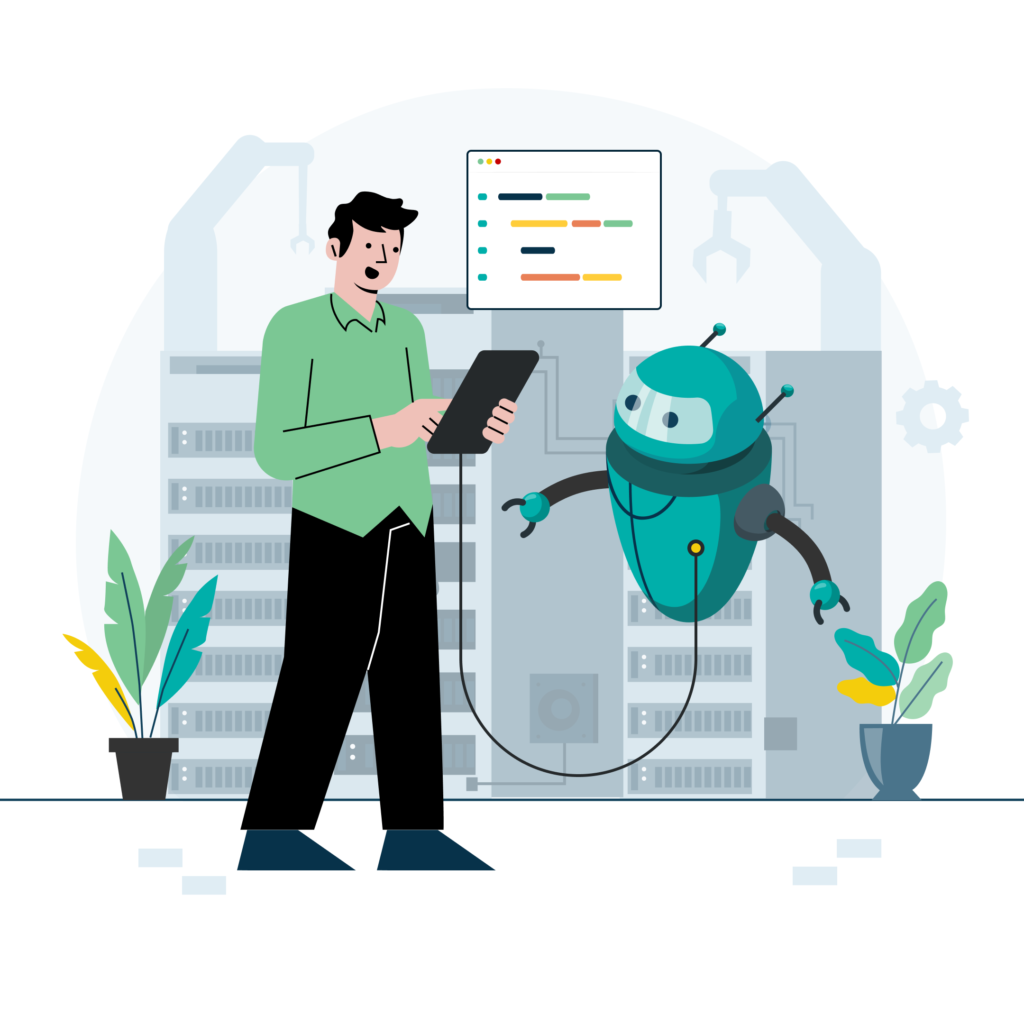The board wants hard numbers on your AI investments. Meanwhile, 95% of AI pilots fail to reach production, and companies are citing AI to justify layoffs without proving actual productivity gains.
Traditional ROI frameworks don’t work for AI. You need something better.
This guide is part of our comprehensive resource on AI-driven workforce restructuring, where we explore the efficiency era transformation. In this article we’re going to give you practical frameworks to measure real AI impact, spot AI-washing when you see it, and avoid becoming another failure statistic. We’ll cover multi-dimensional ROI measurement, how to establish proper baselines, methodologies for getting pilots into production, and detection criteria for AI-washing.
Let’s get into it.
What is AI ROI and how does it differ from traditional ROI?
Traditional ROI is straightforward. You take revenue gains, subtract costs, divide by costs. Simple maths.
AI ROI is messier. You’re not just measuring cost savings. You’re tracking efficiency gains, quality improvements, strategic value, and human impact. The old factory-floor model is inadequate for knowledge work.
There’s a new term emerging – Return on Efficiency (ROE). When revenue attribution is difficult, ROE measures time savings and productivity gains directly.
The difference matters because AI creates value through augmentation and acceleration, not replacement and reduction. As we explore in our complete guide to AI-driven restructuring, you need frameworks that combine financial returns, productivity gains, capability building, and risk mitigation all at once.
Here’s the paradox that tells you everything about measurement challenges: 74% of organisations report meeting ROI expectations while 97% struggle to demonstrate value. That gap is enormous.
Organisations are working around this by combining financial metrics with operational metrics like productivity gains and cycle time reductions. They’re adding strategic metrics like new product introductions and competitive position. Multi-dimensional measurement is the only way to reflect AI’s actual impact.
What metrics should I track to measure AI productivity gains?
Start with efficiency metrics. Self-reported time savings average 2-3 hours per week, with power users reporting 5+ hours. Track task completion acceleration – you’re looking for 20-40% speed improvement in before-after tracking over 30-day periods.
AI suggestion acceptance rates matter. For code suggestions, 25-40% acceptance is typical. Pull request throughput typically increases 10-25% for AI users compared to non-users.
Quality metrics matter too. Track error reduction rates, accuracy improvements, rework elimination. Code review cycle times should decrease 10-20% for AI users.
Then you’ve got productivity metrics including output per developer, sprint velocity changes, feature delivery acceleration. Engineers using AI tools showed 30% increase in pull request throughput year-over-year compared to just 5% among non-adopters.
Don’t ignore strategic metrics either. Time-to-market improvements, innovation capacity, competitive response speed. These are harder to quantify but they’re what the board cares about.
Human metrics provide important context. Developer satisfaction, skill development, retention rates, creative work versus toil ratio. At mature rollouts, 60-70% of developers use AI tools weekly and 40-50% use them daily.
Here’s the catch though – developers may perceive 20-55% productivity improvements while measured gains are often 15-25%. Self-reported productivity is different from actual productivity. You can’t rely on surveys alone. You need objective data from your development systems.
Use three layers of measurement: AI tool adoption metrics (monthly/weekly/daily active users), direct AI impact metrics (time savings, task acceleration), and business impact metrics (pull request throughput, deployment quality).
How do I establish baseline productivity measurements before implementing AI?
You need minimum 4-6 weeks of data collection before introducing AI tools. Without baseline measurement, any improvement claims are just guessing.
Capture current cycle times, output rates, error frequencies, and process bottlenecks. Review the past 6-12 months for seasonal patterns and trend lines. Define consistent measurement criteria across teams.
Establish control groups. Identify teams or individuals not using AI tools for comparison. Use A/B tests where feasible by piloting AI with a subset while keeping others as control.
Same-engineer methodology has become the gold standard. Comparing individual performance before and after AI eliminates variables like tenure, seasonality, and team changes.
Measure baseline metrics like pull request throughput, code review cycle times, deployment success rates. Track the time engineers spend on debugging, documentation, and code review.
For process automation, track manual processes for several weeks to get averages. Average handling time, error rates, output volume. Baselines can be numeric values or qualitative employee feedback on tedious tasks.
Document current pain points. Create a qualitative baseline of frustrations, blockers, manual processes. This helps later when you’re explaining strategic value to executives who don’t live in the code.
Get stakeholder alignment on this. Ensure executives agree on baseline metrics before AI investment. This prevents later disputes about whether improvements are real.
What is AI-washing and how can I detect it in corporate announcements?
AI-washing is citing AI to justify decisions when AI isn’t the actual driver. 48,414 AI-related job cuts were announced in the U.S. in 2024 according to Challenger data. Of those, 31,039 cuts were announced in October 2025 alone.
Here’s the reality though – nearly four in five layoffs in the first half of 2025 were entirely unrelated to AI, and less than 1% were direct results of AI productivity.
Detection signals are straightforward. Look for vague AI references without specific tools or implementations named. Check if timing coincides with cost-cutting pressure rather than genuine AI deployment at scale.
Amazon’s case is instructive. 14,000+ job cuts were attributed to AI efficiency while many eliminated roles had minimal AI interaction. Amazon CEO Andy Jassy later said the October 2025 cuts were “not even really AI-driven, not right now” but blamed bloated bureaucracy instead. For detailed analysis of Amazon’s productivity claims and ROI, see our comprehensive case study examining Jassy’s efficiency narrative.
Red flags include job cuts announced as “AI transformation” without evidence of AI deployment at scale. Pilot programmes cited as if fully operational. Companies talk about using AI to do those jobs in the future, which amounts to AI-washing pure and simple.
Verification is simple. Request specific AI tools deployed, productivity metrics achieved, pilot-to-production timeline, before-after comparison data. If they can’t provide this, you’re looking at AI-washing. For a deeper exploration of distinguishing genuine transformation from AI-washing, see our foundational guide on efficiency era justifications.
Why do 95% of AI pilots fail to reach production?
MIT research found 95% of generative AI pilots in corporate settings deliver zero ROI. The study analysed 300 public AI deployments, 150+ executive interviews, and surveys of 350 employees representing $30-40 billion in investment.
Only about 5% of pilots successfully integrate AI tools into workflows at scale. 88% of AI proof-of-concepts never reach wide-scale deployment.
The reasons are organisational, not technical. Pilots often lack clear success criteria, insufficient baseline measurement, and no production integration planning. Resource mismatch is common – pilots run with dedicated support and budget that disappears at scale.
Technical debt builds when pilots are built without production scalability, security, or compliance requirements. The business case erodes because initial ROI projections don’t account for full production costs.
Successful AI deployments typically involve extensive data preparation phases consuming 60-80% of project resources. Pilots skip this, then hit reality at scale.
Stakeholder alignment gaps kill projects. Technical teams get excited about AI capabilities. Business units remain unconvinced of value. The problem isn’t AI technology itself – it’s how organisations approach AI implementation.
MIT defined success narrowly as “deployment beyond pilot phase with measurable KPIs” and “ROI impact measured six months post pilot.” Most pilots fail these basic criteria.
Generic tools like ChatGPT excel for individuals because of flexibility. They stall in enterprise use since they don’t learn from or adapt to workflows.
To avoid these pitfalls, establish clear success criteria before pilots begin. Plan for production integration from day one. Allocate sufficient resources for data preparation. Design pilots with production scalability, security, and compliance built in.
How do I build a business case for AI implementation that resonates with executives?
Executive priorities are risk mitigation, competitive advantage, measurable returns, and strategic alignment. Your business case structure needs a problem statement, proposed solution, cost breakdown including total cost of ownership, benefit quantification, risk assessment, success metrics, and timeline.
Use conservative ROI estimates with risk-adjusted scenarios and break-even timeline. Position AI as capability building versus cost reduction. Emphasise long-term competitive positioning.
Evidence requirements include pilot data, vendor case studies, third-party research from MIT, Gartner, and Deloitte, plus peer company examples. Board priorities focus on risk management, competitive positioning, and fiduciary responsibility.
Tailor messaging. CFO wants financial returns. CEO wants strategic value. Board wants risk and governance. CTO wants technical feasibility. The successful business case not only aids in getting projects approved but serves as reference throughout to keep it on track.
Here’s an interesting finding: CEO oversight of AI governance is one element most correlated with higher self-reported bottom-line impact. At larger companies, CEO oversight is the element with most impact on EBIT attributable to generative AI.
Include both direct financial impacts and indirect benefits like improved customer satisfaction and employee productivity. Develop comprehensive communication plans addressing employee concerns, explaining AI benefits, and providing regular updates.
Present conservative financial projections with sensitivity analysis, risk mitigation strategies, pilot data with control groups, third-party validation, clear success metrics, governance framework, and exit criteria. Focus on strategic value not just cost savings.
What are the hidden costs of AI implementation that affect ROI calculations?
Infrastructure costs go beyond licensing. GPU compute, API usage fees, data storage, increased bandwidth, scaling expenses beyond pilot. Cloud AI costs are underestimated. Training large models or handling millions of AI requests racks up bills fast.
For a mid-sized organisation of 100 developers, direct licensing costs hit $40,000: GitHub Copilot Business $22,800, OpenAI API $12,000, code transformation tools $6,000.
Training and enablement costs run $10,000+ for internal documentation, office hours, and training sessions. Administrative overhead adds $5,000+ for budget approvals, security reviews, legal negotiations, dashboard maintenance.
Integration costs include connecting AI tools to existing systems, workflow modifications, API development, and security hardening. Maintenance costs cover model updates, tool upgrades, vendor relationship management, and performance monitoring.
Compliance costs involve data privacy reviews, security audits, governance frameworks, and policy development. Data preparation costs are undervalued including data engineering to extract and transform data from various systems.
Change management costs matter too. Resistance management, process redesign, communication campaigns, stakeholder alignment. Then there’s opportunity costs from team time spent on AI evaluation and implementation versus product development.
Total cost of ownership captures all expenses associated with deploying a tool, not just upfront costs, but everything required to integrate, manage, and realise value.
Monitor cloud usage costs closely. Budget for IT support costs for monitoring uptime, security patching, user support tickets. Plan for model retraining costs as data drifts or new data becomes available.
How do I transition from AI pilot to production successfully?
Define clear success criteria for pilot graduation versus termination. Get executive sign-off on thresholds before starting. Organisations require approximately 12 months to overcome adoption challenges and start scaling generative AI.
Your production readiness checklist needs scalability testing, security review, compliance validation, support model, and cost projection. Validate the cost model – pilot costs versus production costs, unit economics, break-even analysis.
Organisations utilising phased rollouts report 35% fewer issues during implementation compared to enterprise-wide deployment. Deploy sequentially rather than all at once.
Implement gradual rollout by deploying to additional teams with measurement at each phase. Adjust based on feedback. Establish success criteria gates to evaluate each phase before proceeding.
Many organisations stumble at the scaling phase. Patience and persistence are needed to break out of pilot stage, but with the right strategy you can shorten that timeline. For comprehensive guidance on using ROI data to inform implementation, see our strategic playbook on measurement-driven change strategies.
Develop role-specific training programmes for different skill levels. Identify and empower AI advocates in each business unit. Maintain consistent messaging about benefits and progress through your communication strategy.
Establish feedback loops for continuous user feedback and rapid issue resolution. Plan integration including production infrastructure, monitoring systems, incident response, and backup plans. Implement hypercare support providing enhanced support during and after each deployment phase.
Regular updates on metrics, transparent reporting of challenges, and course corrections keep stakeholders aligned.
Set criteria for graduating pilots to full deployment and allocate budget for scaling if the pilot succeeds. Exit criteria should specify when to scale, when to pivot, when to kill based on objective data.
FAQ
What percentage productivity gains should I expect from AI coding tools?
Studies show wide variance. Developers self-report 20-40% productivity improvements, but measured gains are often lower. Controlled studies show 55% faster task completion. Set conservative expectations of 15-25% sustained productivity improvement after accounting for learning curves, integration overhead, and tasks that aren’t AI-suitable.
How long does it take to see ROI from AI implementation?
Here’s the typical timeline: 3-6 months for initial productivity signals, 6-12 months for validated ROI with sufficient data, 12-18 months for full business case validation including scale effects. Organisations implementing AI typically see payback in less than six months according to Forrester research. Faster pilots may show results in weeks but often fail to translate to production.
Is ROI the right metric for evaluating AI success?
ROI remains valuable but insufficient on its own. Consider Return on Efficiency for knowledge work, strategic metrics for competitive positioning, quality metrics for output improvement, and human metrics for capability building. Multi-dimensional frameworks provide a fuller picture than financial ROI alone. 65% of organisations now say AI is part of corporate strategy, recognising not all returns are immediate or financial.
How do I measure AI impact on developer productivity specifically?
Track pull request cycle time, code review iterations, bug density, sprint velocity, time to first code, documentation quality, and context-switching frequency. Use A/B testing with control groups. Measure both individual productivity and team-level delivery outcomes. Same-engineer methodology comparing performance before and after has become the gold standard.
What’s the difference between perceived productivity and actual productivity gains?
Developers perceive 24-55% productivity improvements while measured gains are 15-25%. In one study, developers estimated 20% average speedup but were actually slowed down by 19%. The perception gap is driven by faster initial task completion, reduced cognitive load, and improved confidence. Actual measurement requires baseline comparison, control groups, and output quality assessment.
Should I build AI tools internally or buy from vendors for better ROI?
Buy generally delivers faster time-to-value and lower pilot costs. Build offers customisation and competitive differentiation but higher failure risk. The 95% pilot failure rate applies more to internal builds. Buy proven tools first, build only for unique competitive requirements.
How do I know if my AI vendor is delivering real value or just hype?
Request specific metrics from other customers, access to their measurement methodology, pilot programmes with clear success criteria, baseline establishment support, and transparent pricing including scale costs. Red flags include vague productivity claims, no customer references, resistance to pilots, and opaque pricing.
What are the long-term risks of AI-justified layoffs versus actual productivity improvements?
AI-washing layoffs risk loss of institutional knowledge, reduced innovation capacity, damaged employer brand, talent retention problems, and regulatory scrutiny. Genuine productivity improvement redeploys talent to higher-value work, builds capabilities, and improves competitive position. The key difference is headcount reduction versus capability enhancement.
How do I avoid the common pitfalls that lead to 95% AI pilot failure?
Establish baseline before pilot. Define clear success criteria upfront. Plan for production from day one. Allocate change management resources. Measure continuously. Kill failed pilots quickly. Communicate transparently with stakeholders. Budget for full total cost of ownership not just pilot costs.
What frameworks exist for measuring AI success beyond financial ROI?
Multi-dimensional frameworks include efficiency and productivity metrics, revenue impact, quality improvements, strategic value like time-to-market and innovation capacity, and human metrics like satisfaction, retention, and skill development. Berkeley research and Gartner frameworks offer structured approaches to holistic AI value measurement.
How do I present AI investment justification to the board?
Board priorities are risk management, competitive positioning, and fiduciary responsibility. Present conservative financial projections with sensitivity analysis, risk mitigation strategies, pilot data with control groups, third-party validation, clear success metrics, governance framework, and exit criteria. Focus on strategic value not just cost savings.
What questions should I ask before implementing AI in my company?
What specific problem are we solving? Have we established baseline metrics? What does success look like quantitatively? What’s our pilot-to-production plan? What’s the full total cost of ownership including hidden costs? Do we have executive alignment? What’s our change management approach? What are our exit criteria?












